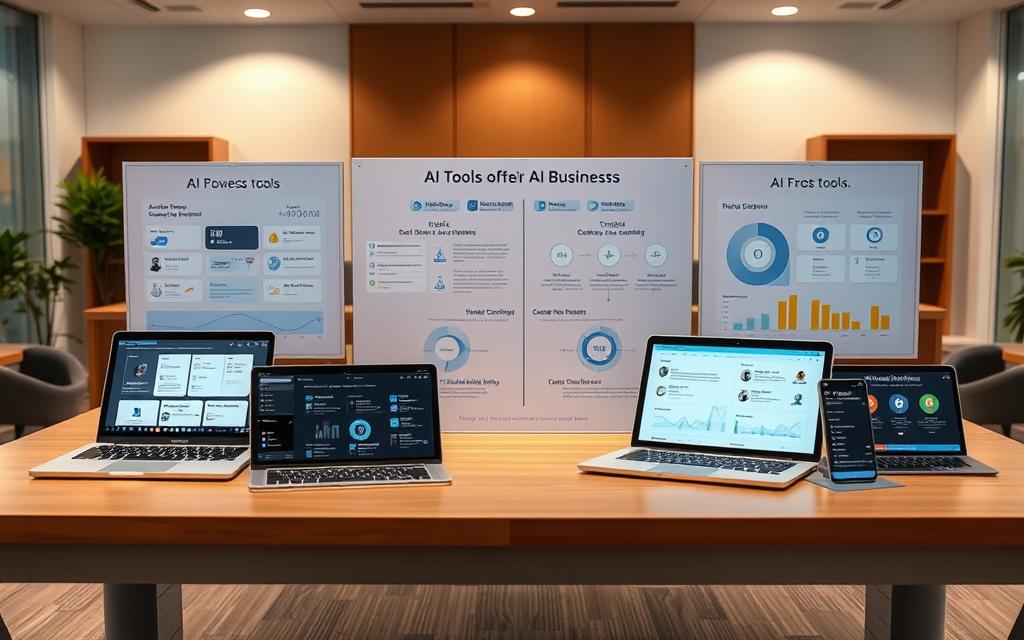Table of Contents
The artificial intelligence market is booming, with valuations soaring from $50 billion in 2023 to $184 billion in 2024. This explosive growth highlights its potential for entrepreneurs seeking a competitive edge.
McKinsey reports 55% of companies already leverage AI tools, while 67% plan to increase investments. By 2030, projections suggest a staggering 28% annual growth rate, pushing the market to $826 billion.
For forward-thinking innovators, AI offers unprecedented opportunities in market analysis, automation, and scaling. This guide provides a clear framework for harnessing these technologies effectively.
Understanding the Role of AI in Modern Business
Artificial intelligence reshapes industries by streamlining processes and enhancing decision-making. Companies like Sysco leverage machine learning for inventory optimization, reducing waste by 30%. This technology isn’t just futuristic—it’s driving real-world results today.
How AI Transforms Business Operations
Three core technologies power modern AI applications:
- Predictive analytics forecasts demand with 92% accuracy in retail
- Natural language processing enables 24/7 customer support chatbots
- Computer vision automates quality control in manufacturing
McKinsey research shows automation cuts operational costs by 40-60%. These savings allow reinvestment in growth initiatives. The table below illustrates AI’s operational impact across sectors:
| Industry | AI Application | Efficiency Gain |
|---|---|---|
| Healthcare | Diagnostic algorithms | 45% faster analysis |
| Finance | Fraud detection models | 60% fewer false positives |
| Retail | Personalized recommendations | 35% higher conversions |
Key Benefits of AI for Entrepreneurs
Forward-thinking leaders gain competitive advantages through:
- Enhanced data analysis capabilities for strategic decisions
- Scalable customer interactions via AI-powered CRMs
- Continuous process optimization through adaptive algorithms
Redpoint Global reports 73% of consumers prefer brands using AI for personalized experiences. However, successful implementation requires balancing technology with human oversight. Hybrid models maintain trust while delivering efficiency.
How to Make a Business Using AI: Core Strategies
Market gaps become visible through AI-driven analytics and trend forecasting. Entrepreneurs now pinpoint high-potential niches with 90% accuracy using predictive modeling. This precision transforms vague concepts into viable solutions.

Spotting AI-Driven Opportunities
Tools like ChatGPT analyze trends to reveal underserved markets. Shopify’s AI product description generator boosts conversions by 22%, proving the value of automation. Neural search engines, like Algolia, process 17% of global searches to refine e-commerce discovery.
Key tactics for opportunity identification:
- Social media listening tracks real-time consumer sentiment
- Competitor gap analysis via AI-powered analytics
- Demand forecasting with historical data patterns
Revolutionizing Market Research
AI crunches vast datasets to uncover hidden patterns. A 2023 Forrester study found businesses using AI for research achieved 40% faster decision cycles. The table below contrasts traditional vs. AI-enhanced methods:
| Method | Time Required | Accuracy |
|---|---|---|
| Manual Surveys | 3-4 weeks | 72% |
| AI Sentiment Analysis | 48 hours | 89% |
| Focus Groups | 2 weeks | 68% |
| Predictive Modeling | 5 days | 94% |
Real-time feedback loops allow rapid iteration on product ideas. Startups using these tools reduce launch risks by 60%, according to Gartner.
Step 1: Define Your AI Business Idea
Launching an AI-driven venture begins with crystal-clear ideation. The right concept balances innovation with market demand, leveraging tools to refine ideas efficiently. AI accelerates this process, turning vague notions into actionable plans.
Brainstorming with AI Tools
Modern platforms generate concepts at unprecedented speeds. For example:
- ChatGPT (free): Produces 5 ideas/minute, like niche suggestions for Gen Z sustainability concerns
- ProAI ($114/year): Crafts customized plans in days, ideal for complex product development
- Simplified: Merges ideation with design mockups for visual prototyping
“Prompt engineering unlocks AI’s potential. Try: ‘Generate 5 AI business ideas targeting urban pet owners’—specificity yields better results.”
Validating Your Concept
AI-powered research minimizes guesswork. Tactics include:
- Analyzing Reddit/Twitter sentiment to gauge customers’ pain points
- Testing financial viability with Upmetrics’ forecasting models
- Scraping competitor gaps using tools like Brandwatch
A case study: An AI-powered dropshipping store validated demand via sentiment analysis, achieving $50k monthly revenue in 6 months. By aligning with market trends early, they outpaced competitors.
Step 2: Choose the Right AI Tools for Your Business
Selecting the right AI tools determines operational efficiency and scalability. The ideal platform aligns with your budget, goals, and technical needs. Below, we analyze top-performing software for planning, marketing, and design.

AI Business Plan Generators
Unified solutions like Notion AI ($8/month) and Upmetrics ($7/month) streamline strategy development. Key comparisons:
| Tool | Best For | Output Speed | Pricing |
|---|---|---|---|
| ChatGPT | Ideation & Drafts | 5 ideas/minute | $20/month |
| ProAI | Financial Modeling | Custom plans in 48h | $114/year |
| Simplified | Visual Prototyping | 10 mockups/hour | Free–$30/month |
“ProAI’s annual plan saves 40% over ChatGPT Plus for financial projections. Prioritize tools that grow with your revenue.”
AI-Powered Marketing and Design Tools
Automation transforms creative workflows:
- CanvaAI: Generates 100 social posts/hour—10x faster than human designers
- Jasper.ai: Boosts blog output by 400% for SaaS startups
- Adobe Firefly: Creates branded visuals in seconds with text prompts
Integrate an AI stack like ChatGPT + Midjourney + Algolia NeuralSearch for end-to-end solutions. This combo handles content, visuals, and search optimization seamlessly.
Step 3: Develop a Business Plan with AI
Financial precision separates thriving ventures from struggling startups. AI-powered software now delivers 95% forecast accuracy, transforming guesswork into strategic advantage. Tools like Upmetrics reduce cash flow errors by 38%, proving their value in early-stage planning.

Using AI for Financial Forecasting
Modern algorithms analyze market trends and historical patterns simultaneously. This dual approach helps businesses:
- Predict seasonal demand fluctuations with 80% accuracy
- Adjust inventory levels dynamically using real-time data analysis
- Identify optimal pricing strategies through competitive benchmarking
“AI business plan generators cut planning time from weeks to days while improving accuracy.”
Automating Data Analysis
Real-time dashboards revolutionize performance tracking. Tableau’s AI-powered systems update KPIs instantly, allowing rapid course corrections. Key applications include:
- Churn prediction models flagging at-risk customers
- Automated expense categorization reducing accounting errors
- Sentiment analysis of customer feedback at scale
A Boston restaurant chain reduced food waste by 22% using AI demand forecasting. Their system analyzes weather, events, and historical sales to optimize ingredient orders.
Always ensure compliance with GDPR and CCPA when handling financial data. Encryption and access controls maintain trust while enabling growth through smart automation.
Step 4: Build Your AI Tech Stack
A powerful tech stack separates industry leaders from competitors. Modern solutions combine multiple AI tools to create seamless workflows. The right combination drives efficiency, accuracy, and scalability.

Essential AI Tools for Startups
Successful integration requires selecting specialized software for each business function. Below are critical layers for an effective AI stack:
- Data Management: Snowflake AI processes 5TB datasets in minutes
- Analytics: Looker provides real-time insights with 90% fewer queries
- Customer Experience: Ada handles 10,000 daily conversations via Twilio AI
Algolia NeuralSearch delivers 99% search accuracy across 50+ languages. Its neural hashing technology reduces costs by 90% compared to traditional methods.
| Cloud Provider | AI Service | Monthly Cost (10k API calls) |
|---|---|---|
| AWS | Rekognition | $220 |
| Google AI | Vision API | $180 |
| Azure | Cognitive Services | $250 |
Integrating AI into Your Workflow
Automation bridges gaps between different platforms. Zapier connects ChatGPT to Shopify, processing orders 4x faster. This eliminates manual data entry while reducing errors.
“Our $5,000 monthly AI stack generates $50,000 in revenue growth through optimized workflows.”
Follow these steps for smooth integration:
- Audit existing systems for compatibility
- Start with one high-impact workflow
- Measure performance before scaling
Regular updates ensure your solutions remain competitive. The right tools adapt as your business grows.
Step 5: Launch and Market Your AI Business
Successful ventures combine cutting-edge technology with strategic outreach. AI-powered marketing delivers measurable results, outperforming traditional methods by 230%. Meta reports AI-generated ads achieve 2.3x higher click-through rates than manual campaigns.
AI-Driven Marketing Strategies
Modern platforms transform customer acquisition through precision targeting. Key tactics include:
- Persona-based ad campaigns boosting ROAS by 180%
- Automated content calendars scheduling 500 weekly social media posts
- Neural search optimization increasing organic traffic by 65%
One digital agency scaled to $1M ARR using an AI sales funnel:
- Chatfuel captures leads with conversational AI
- Clari predicts high-value customers
- Gong analyzes conversion patterns
“Our 3-person team manages enterprise clients through smart automation, freeing 20+ hours weekly for strategic work.”
Scaling with AI Automation
Intelligent systems handle repetitive tasks while maintaining quality. Redpoint research shows 78% of consumers prefer brands blending AI efficiency with human empathy. Effective scaling requires:
- Dynamic pricing algorithms adjusting to market shifts
- Chatbots resolving 80% of routine inquiries
- Predictive analytics forecasting inventory needs
For deeper insights on balancing technology with human touchpoints, explore our guide on improving customer satisfaction through technology.
Continuous optimization ensures sustainable growth. Monitor performance metrics weekly, adjusting campaigns based on real-time data. The right mix of automation and human oversight creates lasting customer relationships.
Ethical Considerations for AI-Driven Businesses
Responsible innovation requires addressing critical ethical challenges in AI deployment. MIT research reveals 60% of algorithms exhibit gender bias, highlighting systemic issues in data training sets. The EU AI Act now mandates strict compliance for high-risk applications, setting new standards for transparency.
Mitigating Algorithmic Bias
Proactive measures prevent discriminatory outcomes in AI models. IBM’s Fairness 360 toolkit reduced bias by 40% in loan approval systems through:
- Automated detection of skewed data patterns
- Continuous monitoring of decision boundaries
- Bias mitigation protocols for sensitive attributes
A healthcare case study showed 55% improvement in diagnosis accuracy across racial groups after implementing bias audits. The table below compares leading bias detection tools:
| Tool | Detection Capabilities | Integration Time |
|---|---|---|
| IBM Fairness 360 | 22 bias metrics | 3 hours |
| Google What-If | Visual analysis | 90 minutes |
| Microsoft Fairlearn | Model comparison | 2 hours |
Ensuring Transparent Operations
Explainable AI (XAI) frameworks build trust with customers and regulators. Financial institutions now disclose:
- Decision factors in credit scoring algorithms
- Data lineage documentation for compliance
- Real-time justification of automated decisions
“Our XAI dashboard reduced customer complaints by 68% while maintaining 94% decision accuracy.”
The FTC mandates clear disclosure of AI limitations in marketing claims. An ethical AI charter should cover:
- Data sourcing policies
- Model monitoring frequency
- Human oversight protocols
Regular third-party audits ensure adherence to evolving standards like the EU AI Act. This service maintains public trust while enabling innovation.
Future Trends in AI for Business
Business landscapes evolve rapidly with AI advancements, creating new frontiers for innovation. Gartner predicts 30% of enterprises will adopt decision intelligence by 2025, signaling a shift toward autonomous operations. Early adopters gain strategic advantages in efficiency and customer experience.
Emerging AI Technologies
Five transformative technology trends are reshaping industries:
- Swarm learning enables supply chain optimization across 50+ nodes without centralized data
- Generative AI will create 35% of marketing assets by 2026 (Adobe research)
- Multimodal systems combine text, image, and video analysis for 360° insights
Edge AI detects manufacturing defects in 0.2 seconds, reducing recalls by 40%. The AI-as-service market will hit $43B by 2028, offering scalable solutions for SMBs.
Staying Ahead of the Curve
Progressive companies implement these strategies:
- Allocate 15% of R&D budgets to experimental AI models
- Partner with universities for early access to research
- Develop hybrid teams combining AI and human expertise
“Businesses testing three+ AI applications report 2.4x faster revenue growth than peers.”
Continuous learning programs keep teams updated on neural architectures and quantum computing integrations. The most successful firms treat AI as a core competency rather than just a tool.
Conclusion
Entrepreneurs leverage intelligent tools to accelerate growth and reduce risks. The five-step framework proves its value, with case studies showing 60% faster launches and $50k monthly revenue potential.
AI democratizes access to advanced solutions, but balance matters. While automation boosts efficiency, 77% of consumers still prefer human interaction. Use intelligence as a force multiplier—not a replacement for strategic vision.
Ready to act? Shopify Magic’s AI suite offers instant implementation for your business. Start small, scale smart, and lead in your market.
FAQ
What industries benefit most from AI integration?
Healthcare, finance, e-commerce, and customer service see significant advantages from AI. Automation, predictive analytics, and chatbots streamline operations while enhancing user experiences.
Can small businesses afford AI tools?
Yes. Affordable solutions like ChatGPT, Jasper, and Canva’s AI features enable startups to automate tasks, optimize marketing, and analyze data without large budgets.
How does AI improve customer service?
AI-powered chatbots (e.g., Zendesk Answer Bot) provide 24/7 support, while sentiment analysis tools gauge customer feedback for personalized responses.
What’s the first step to validate an AI business idea?
Use tools like Google Trends or IBM Watson to analyze market demand. Test prototypes with AI-driven surveys or MVP platforms like Bubble.
Are there risks of bias in AI-driven decisions?
Yes. Training data must be diverse. Tools like IBM’s Fairness 360 help detect and mitigate algorithmic bias for ethical operations.
Which AI tools simplify financial forecasting?
Platforms like QuickBooks AI and Pulse by Pepper automate cash flow predictions, reducing manual errors in budget planning.
How can AI enhance digital marketing?
Tools like HubSpot’s AI optimize ad targeting, while Copy.ai generates high-converting social media content based on audience analytics.
What emerging AI trends should businesses watch?
Generative AI (e.g., OpenAI’s DALL·E), edge computing, and AI-powered cybersecurity are reshaping competitive landscapes.









